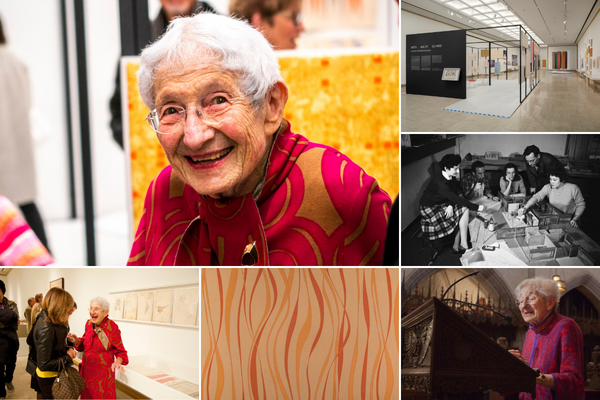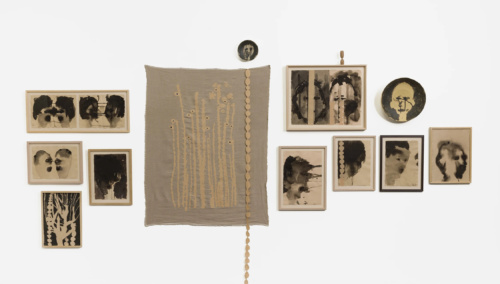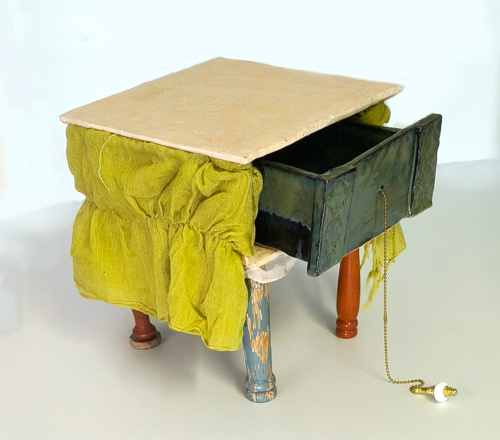Cranbrook Mourns the Passing of Ruth Adler Schnee

Image credits: Clockwise from upper left: (1) Ruth Adler Schnee at Cranbrook Art Museum for the opening of her exhibition “Ruth Adler Schnee: Modern Designs for Living,” 2019. Photo: Sarah Blanchette. (2) “Ruth Adler Schnee: Modern Designs for Living” at Cranbrook Art Museum, 2019. Photo: PD Rearick. (3) Ruth at Cranbrook Academy of Art, 1946. (4) Ruth receiving the Distinguished Alumni Award at Cranbrook Academy of Art Commencement, 2015 (5) Ruth Adler Schnee’s “Strata (reinterpreted)” for KnollTextiles. Designed in 1947, and manufactured in 2012. CollectionCranbrook Art Museum. Gift of the artist. Photo: PD Rearick. (6) Ruth Adler Schnee at the opening of “My Brain is in My Inkstand” at Cranbrook Art Museum, 2016.
Bloomfield Hills, Mich., Jan. 6, 2023 — Today, Cranbrook Educational Community mourns the passing of iconic Detroit textile and interior designer, Ruth Adler Schnee.An innovator whose keen eye and talent for creating contemporary designs shaped the look and feel of the midcentury modern movement, Ruth Alder Schnee led a storied seven-decade career. She passed away on January 5, 2023. She was 99 years old.“The life and legacy of Ruth Adler Schnee have long been celebrated at Cranbrook Academy of Art,” says Paul Sacaridiz, the Maxine and Stuart Frankel Director of Cranbrook Academy of Art. “She was a designer who not only saw the beauty and color in the world but had the diligence and talent to translate her vision into designs that brightened the lives of millions throughout her lifetime and will continue to inspire generations for years to come.”Adler Schnee was one of the first women to graduate from Cranbrook Academy of Art in 1946. Born to a German Jewish family in Frankfurt, Germany, her mother’s Bauhaus training and creative circle of friends developed her interest in the vibrant use of colors, rich textures, modern form, and the thoughtful study of architectural space from an early age. Following the Nazis’ Kristallnacht pogrom of 1938, the Adler family fled to the United States and settled in Detroit.She first studied fashion design at Cass Technical High School and then won a four-year scholarship to study interior architecture at the Rhode Island School of Design, graduating in 1945. She went on to hold a brief position as an assistant designer in the New York firm of Raymond Loewy (the result of winning a Condé Nast Prix de Paris award) that ended when she received a fellowship to Cranbrook Academy of Art. Adler Schnee received an MFA in Design from Cranbrook Academy of Art in 1946. Of her time at Cranbrook, Adler Schnee said, “it was the most exhilarating experience to watch my work unfold from day to day. Evenings at Saarinen House are long remembered. Discussion on design and creative processes were always the topic. Loja would be ensconced on a hard bench, cushioned by only one of her tapestries draped from the ceiling, across the bench and to the floor. Eliel sat on a stiff ceremonial chair of his own design. He was exceedingly comfortable there, so he always said. We students lounged at their feet. There, I learned design discipline. I learned the philosophy which governs my entire life. In Eliel’s words, ‘Art and Design cannot be taught; it must be learned.’”Upon graduating, she entered a Chicago Tribune “Design for Better Living” competition, earning a prize and recognition which started her career in fabric design. She began winning other prizes and recognition for her fabric designs almost immediately. Early awards include the 1948 American Institute of Designers’ first award in printed fabrics for her design “Strata”; prizes, awards, and honorable mentions in many of the Detroit Institute of Arts (DIA) Michigan Artist-Craftsmen exhibitions, from 1949 and into the fifties; recognition in the International Textile Exhibitions at the University of North Carolina; and selection in the Young Designers competition at the Akron Art Institute in 1954.She went on to found a design consulting firm and modern design shop in Detroit with her husband Edward Schnee in 1948. Edward made the silk screen prints that Adler Schnee designed, and their successful business brought modernism to Michigan through the 1970s. Their store was one of the first in the country to sell modern furniture and fabrics. She also received commissions to contribute drapery to the Ford Rotunda in Dearborn, and her designs could be seen at the General Motors Technical Center in Warren and Yamasaki’s World Trade Center in New York.Adler Schnee developed interior designs with numerous modern architects, including Eero Saarinen, Buckminster Fuller, and Minoru Yamasaki. In the 1990s her designs were reissued by Unika Vaev, translated into woven fabrics by Anzea, and adapted by Knoll Textiles in 2012. In 2015, she signed a new 20-year contract with Knoll to continue creating designs for the company.Other notable awards and accolades during her career include the 2015 Kresge Eminent Artist Award, the Women in the Arts Lifetime Achievement Award, and the American Institute of Architects International Color Award. In 2010, she received an honorary doctorate from the Center for Creative Studies in Detroit, and in 2011 she showcased a solo exhibition at the Venice Biennale and at the Smithsonian in 2012. She received the Distinguished Alumni Award from Cranbrook Academy of Art in 2015.In 2019, Cranbrook Art Museum presented the original exhibition and accompanying publication, Ruth Adler Schnee: Modern Designs for Living. According to Cranbrook Art Museum Director Andrew Blauvelt, “the exhibition aimed to remedy the underrepresentation of Ruth’s pivotal role in the development of the American midcentury modern interior in design history.”Blauvelt says, “Ruth was a pioneer in design and in life—escaping the anti-Semitism and fascism of WWII and building her business as a woman in America in the 1940s by developing her remarkable textile and interior designs and becoming a staunch advocate of modernism.”Blauvelt continues, “I first encountered her work in the exhibition Vital Forms, organized by the Brooklyn Museum when it traveled to the Walker Art Center in Minneapolis in the early 2000s. Her important contributions to the field were just beginning to reemerge. Years later, in Detroit, we met as we toured through an exhibition on the life and work of Charles and Ray Eames—like so many icons of 20th-century design they were friends of Ruth, of course—and we made an agreement to do a retrospective of her work and life in design at Cranbrook, her alma mater. Ruth was an utter delight to work with as we prepared her retrospective exhibition and publication in 2019. Ruth and her family were so generous in sharing her story with the public and entrusting us with the care of her work. We extend our deepest condolences to the Schnee family, Ruth’s friends, and extended family.”Adler Schnee maintained a strong connection to Cranbrook throughout her life and career. In 2010, Cranbrook Archives, which is now a part of the Cranbrook Center for Collections and Research, accessioned all of the Edward and Ruth Adler Schnee Papers to its permanent collection. In 2021, the Art Museum, with the help of the family, accessioned a large collection of textiles of her work as a gift of Ruth Adler and Edward C. Schnee.You can explore Cranbrook Art Museum’s exhibition virtually, here. To explore what is included in the Edward and Ruth Adler Schnee Papers, click here. Cranbrook Educational Community extends its condolences to Ruth’s family and will continue to celebrate her remarkable legacy.


